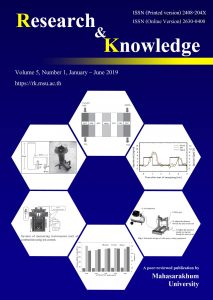Injection Characteristics of Gasohol using a Common Rail Injection System
Keywords:
Gasohol, Fuel Injection Characteristics and Common Rail Injection SystemAbstract
The worldwide emission regulations for compression ignition (CI) engines have become more stringent driven by global warming issues and public health concerns. A promising solution to decrease greenhouse gas and emissions from CI engines is gasohol considered as a fuel-replacing diesel. The objective of this study is to study effect of gasohol on fuel injection characteristics of a common rail injection system used in CI engines. Gasohol E85, containing 85% ethanol and 15% gasoline, is tested and conventional diesel is a reference fuel. An injection measurement device based on Zeuch method was used for investigating the injection characteristics including injected amount and discharge coeffi cient. Gasohol were injected with both single and double injection strategies at a constant injection pressure of 450 bar into a back-pressure of 40 bar. The fi ndings of this study clearly show that injection characteristics of gasohol were signifi cantly differed from those of diesel, due to physical properties changed. At the same injection conditions, injected fuel rate are different.
References
Benajes J, Payri R, Molina S, Soare V. (2005). Investigation of the influence of injection rate shaping on the spray characteristics in a diesel common rail system equipped with a piston amplifier, Journal of Fluids Engineering, Transactions of the ASME, vol. 127, pp. 1102 – 1110.
Bower, G. and Foster, D. (1991). A Comparison of the Bosch and Zuech Rate of Injection Meters, SAE Technical Paper 910724,doi: https://doi.org/10.4271/ 910724.
Dec, J., Yang, Y., Dernotte, J., and Ji, C. (2015). Effects of gasoline reactivity and ethanol content on boosted, premixed and partially stratified low-temperature gasoline combustion (LTGC), SAE International Journal of Engines, vol.8(3), pp. 935 – 955.
Hanson, R., Splitter, D., and Reitz, R. (2009). Operating a heavy-duty direct-injection compression-ignition engine with gasoline for low emissions, SAE Technical Paper 2009-01-1442, doi:10.4271/ 2009-01-1442.
Hasegawa, R., and Yanagihara, H. (2003). HCCI combustion in di diesel engine, SAE Technical Paper 2003- 01-0745, doi:10.4271/2003-01-0745.
Hildingsson, L., Johansson, B., Kalghatgi, G., and Harrison, A. (2010). Some effects of fuel autoignition quality and volatility in premixed compression ignition engines, SAE International Journal of Engines, vol.3(1), pp. 440 – 460.
Ikeda, T., Ohmori, Y., Takamura, A., Sato, Y., Jun, L and Kamimoto, T. (2001). Measurement of the rate of multiple fuel injection with diesel fuel and DME. SAE Technical Paper 2001-01-0527. doi: https://doi. org/10.4271/2001-01-0527.
Johansson B. (2005). High-load partially premixed combustion in a heavy-duty diesel engine, paper presented in the Diesel Engine Emissions Reduction (DEER) Conference Presentations 2005, Chicago, USA.
Kaiadi, M., Johansson, B., Lundgren, M., and Gaynor, J. (2013). Experimental investigation on different injection strategies for ethanol partially premixed combustion, SAE Technical Paper 2013-01-0281, doi:10.4271/2013-01-0281.
Kalghatgi, G., Risberg, P., and Ångström, H. (2006). Advantages of fuels with high resistance to auto-ignition in late-injection, low-temperature, compression ignition combustion, SAE Technical Paper 2006-01- 3385, doi:10.4271/2006-01-3385.
Kalghatgi, G., Risberg, P., and Ångström, H. (2007). Partially pre-mixed auto-ignition of gasoline to attain low smoke and low nox at high load in a compression ignition engine and comparison with a diesel fuel, SAE Technical Paper 2007-01-0006, doi:10.4271/ 2007-01-0006.
Labreche, A., Foucher, F., and Rousselle, C.M. (2009). Impact of the second injection characteristics and dilution effect on gasoline partially premixed combustion, SAE Technical Paper 2014-01-2673, doi:10.4271/2014-01-2673.
Manente V., Johansson, B., and Tunestal, P. (2009). Half load partially premixed combustion, ppc, with high octane number fuels. gasoline and ethanol compared with diesel, paper presented in the Symposium on International Automotive Technology (SIAT) 2009, Pune, India.
Manente, V., Johansson, B., and Tunestal, P. (2009). Partially premixed combustion at high load using gasoline and ethanol, a comparison with diesel, SAE Technical Paper 2009-01-0944, doi:10.4271/2009- 01-0944.
Manente, V., Tunestal, P., Johansson, B., and Cannella, W. (2010). Effects of ethanol and different type of gasoline fuels on partially premixed combustion from low to high load, SAE Technical Paper 2010- 01-0871, doi:10.4271/2010-01-0871.
Manente, V., Johansson, B. and Cannella, W. (2011). Gasoline partially premixed combustion, the future of internal combustion engines?, International Journal of Engine Research, vol.12, 194 – 208.
Marcic, M. (2006). Sensor for injection rate measurements, Sensors, vol. 6, pp. 1367 – 1382.
Munsin, R., Laoonual, Y., Jugjai, S., Matsuki, M. and Kosaka, H. (2015). Effect of glycerol ethoxylate as an ignition improver on injection and combustion characteristics of hydrous ethanol under CI engine condition. Energy Conversion and Management, vol. 98, 282–289.
Munsin, R., Pinazzi, P., Foucher, F., Truedsson, I. and Rousselle, C.M. (2017). Effect of fuel injection ratio on partially premixed combustion of ethanol blends, paper presented in the 8th TSME International Conference on Mechanical Engineering, Bangkok, Thailand.
Noehre, C., Andersson, M., Johansson, B., and Hultqvist, A. (2006). Characterization of partially premixed combustion, SAE Technical Paper 2006-01-3412, doi:10.4271/2006-01-3412.
Payri, R., García, A., Domenech, V., Durrett, R., Plazas, A. H. (2012). An experimental study of gasoline effects on injection rate, momentum flux and spray characteristics using a common rail diesel injection system. Fuel, vol. 97, pp. 390 – 399.
Rousselle, C.M., Foucher, F., and Labreche, A. (2013). Optimization of gasoline partially premixed combus - tion mode, SAE Technical Paper 2013-01-2532, doi:10.4271/2013-01-2532.
Sjöberg, M., and Dec, J. (2006). Smoothing HCCI heatrelease rates using partial fuel stratification with two-stage ignition fuels, SAE Technical Paper 2006- 01-0629, doi:10.4271/2006-01-0629.
Srichai, P., Ewphun, P. P., Charoenphonphanich, C., Karin, P., Tongroon, M., and Chollacoop, N. (2018). Injec - tion characteristics of palm methyl ester blended with diesel using zuech’s chamber, International Journal of Automotive Technology, vol. 19(3), pp. 535 – 545.
Thring, R. (1989). Homogeneous-charge compressionignition (HCCI) engines, SAE Technical Paper 892068, doi:10.4271/892068.
Yao, M., Zheng, Z., and Liu, H. (2009). Progress and recent trends in homogeneous charge compression ignition (HCCI) engines, Progress in Energy and Combustion Science, vol.35, pp. 398 – 437.
Downloads
Published
How to Cite
Issue
Section
License

This work is licensed under a Creative Commons Attribution-NoDerivatives 4.0 International License.








